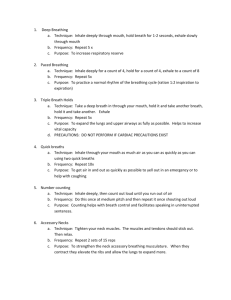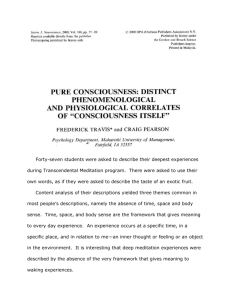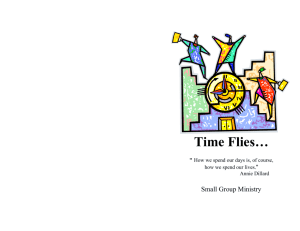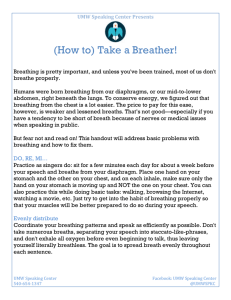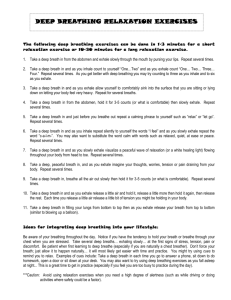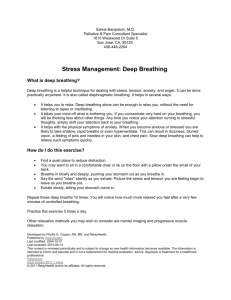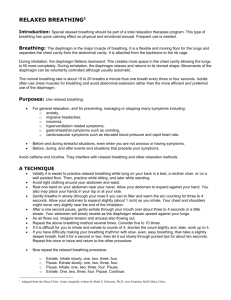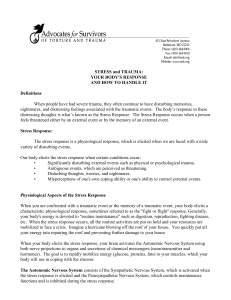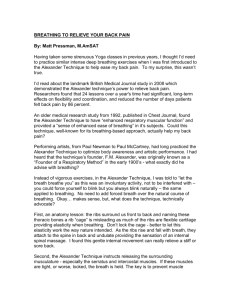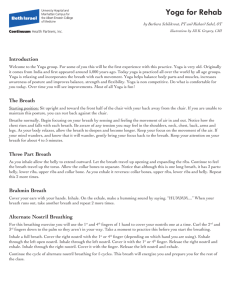this tool.
advertisement
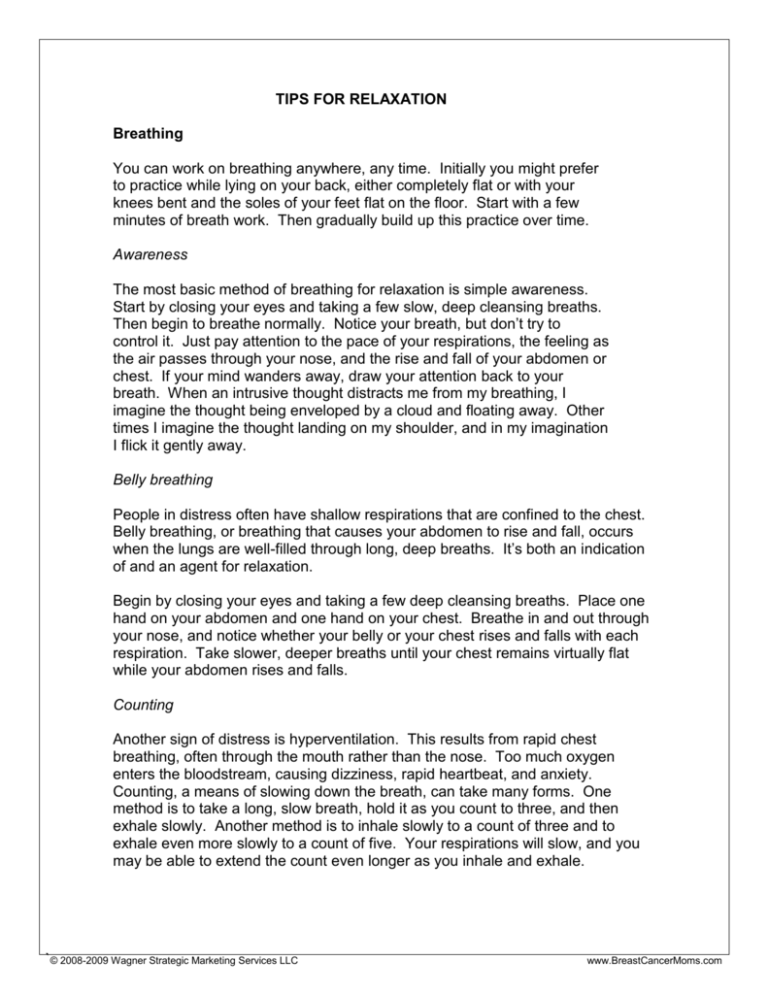
TIPS FOR RELAXATION Breathing You can work on breathing anywhere, any time. Initially you might prefer to practice while lying on your back, either completely flat or with your knees bent and the soles of your feet flat on the floor. Start with a few minutes of breath work. Then gradually build up this practice over time. Awareness The most basic method of breathing for relaxation is simple awareness. Start by closing your eyes and taking a few slow, deep cleansing breaths. Then begin to breathe normally. Notice your breath, but don’t try to control it. Just pay attention to the pace of your respirations, the feeling as the air passes through your nose, and the rise and fall of your abdomen or chest. If your mind wanders away, draw your attention back to your breath. When an intrusive thought distracts me from my breathing, I imagine the thought being enveloped by a cloud and floating away. Other times I imagine the thought landing on my shoulder, and in my imagination I flick it gently away. Belly breathing People in distress often have shallow respirations that are confined to the chest. Belly breathing, or breathing that causes your abdomen to rise and fall, occurs when the lungs are well-filled through long, deep breaths. It’s both an indication of and an agent for relaxation. Begin by closing your eyes and taking a few deep cleansing breaths. Place one hand on your abdomen and one hand on your chest. Breathe in and out through your nose, and notice whether your belly or your chest rises and falls with each respiration. Take slower, deeper breaths until your chest remains virtually flat while your abdomen rises and falls. Counting Another sign of distress is hyperventilation. This results from rapid chest breathing, often through the mouth rather than the nose. Too much oxygen enters the bloodstream, causing dizziness, rapid heartbeat, and anxiety. Counting, a means of slowing down the breath, can take many forms. One method is to take a long, slow breath, hold it as you count to three, and then exhale slowly. Another method is to inhale slowly to a count of three and to exhale even more slowly to a count of five. Your respirations will slow, and you may be able to extend the count even longer as you inhale and exhale. `© 2008-2009 Wagner Strategic Marketing Services LLC www.BreastCancerMoms.com Mantras Breathing with a mantra, or an unspoken word, is another means for focusing on your breath and slowing down respiration. Many yoga practitioners use the words so hum, which mean, “I am that.” So hum also reflects the sounds of your respiration: inhalation (so) and exhalation (hum). As you pay attention to your breath, simply say the word so to yourself as you inhale and hum as you exhale. Any word will do. The word shalom is another good choice. Shalom, a Hebrew word, means hello, goodbye, and peace. Say sha- to yourself as you inhale and -lom to yourself as you exhale. Imagine that you’re saying hello to peacefullness as you inhale and goodbye to stress as you exhale. Visualization Another method of calming the mind is visualization. This practice uses your mind’s eye to picture a scene that restores you. Some people like to visualize a favorite place, such as a beach or a garden. Others like to visualize a location that embodies a feeling they’re trying to capture, such as a peaceful forest, a soothing rainstorm, or a tranquil pond. Find a quiet, comfortable place where you won’t be interrupted or distracted. Close your eyes and take a few deep cleansing breaths. Begin to visualize a scene. Imagine, for example, that you’re sitting at the edge of a dock on a quiet lake. See the visual aspects of this scene—the gentle ripples on the lake, the sailboats in the distance, the rocks at the bottom of the clear water. Hear the sounds of the scene—the quiet lapping of the water along the beach, the distant hum of a motor boat, the rustle of the leaves along the shore. Feel the sensations you might have as you sit there—the rough wood of the dock, the warmth of the sun on your face, the tickle of the water on your toes. Finally, smell the scents—the pungent pine needles and the musty boathouse. By concentrating on this visualization, you will have slowed your respiration, calmed your mind, and created a general sense of well-being. Progressive Relaxation With this technique, you relax every part of your body by tensing and then releasing your muscles, working progressively from one end of your body to the other. Begin by lying down in a quiet place where you won’t be interrupted. Close your eyes, and take a few deep cleansing breaths. Concentrate on your forehead. Tighten the muscles for 5 to 10 seconds and then release them. Move on to your mouth, tightening the muscles for several seconds and then releasing them. Progress downward to your neck. When you release a set of muscles, visualize that area of your body melting like wax or sinking like a lead weight into the surface beneath you. Continue with this process until you have `© 2008-2009 Wagner Strategic Marketing Services LLC www.BreastCancerMoms.com relaxed the muscles in your entire body. Spend several minutes allowing your body to enjoy this state of relaxation. Then gently open your eyes and reacclimate yourself to your surroundings. In addition to the techniques described above, breast cancer patients can soothe themselves through journaling, listening to comforting music, or simply visiting with friends. Whichever form you choose, practice daily. You will become more proficient, and the benefits are cumulative. When we have breast cancer, it seems as if our lives are consumed with taking care of ourselves—physical exams, surgery, chemotherapy, radiation, blood tests, bone scans, MRIs and more. Yet taking care of ourselves should extend beyond the hospital and the physician’s office. As mothers with breast cancer, we must pay as much attention to restoring our mind, body, and soul as to battling our disease. `© 2008-2009 Wagner Strategic Marketing Services LLC www.BreastCancerMoms.com

